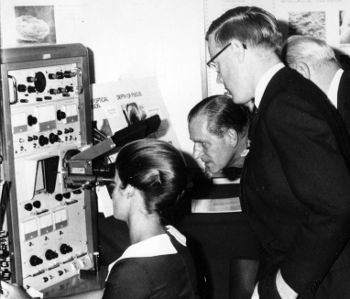In 1965, the first commercial Stereoscan SEM was built by Cambridge Instrument Company, a UK based predecessor company of Carl Zeiss Microscopy Ltd.
To mark the anniversary of this very first SEM sale 50 years ago, and celebrate the contributions to scientific research across so many fields and industries made possible through scanning electron microscopy, ZEISS hosted a celebratory event in Cambridge yesterday.
 The first commercial SEM being demonstrated by Celia Moss to Prince Philip, with Garry Stewart and Sir Charles Oatley
The first commercial SEM being demonstrated by Celia Moss to Prince Philip, with Garry Stewart and Sir Charles Oatley
During a morning of talks, lunch, and a museum tour, customers and specialists from many disciplines had the chance to meet scientists who worked on the development of the first commercial SEMs.
With 50 years of continuous growth and development, the SEM has become ever more versatile, and is now firmly established as an indispensable tool for advanced research across many scientific disciplines. With new industrial applications emerging every year, the SEM is also a vital part of research & development, and quality control & analysis across an extensive range of industries around the globe.
From its early home in materials science, the SEM established itself in the disciplines of electronics, forensics and archaeology. Over the years it has evolved into a key tool for food technologists, biologists, geologists and petrologists in the natural resources industries, adapting subtly to fulfil the discrete requirements of these individual applications.
Use of SEMs for process control and failure analysis is now widespread, with routine analysis on SEMs an integral part of the semiconductor and automotive industries, and manufacture more broadly.
Development still goes on: A direct descendant of the first microscopes produced in Cambridge in 1965 is the ZEISS EVO family. First launched in 2004, and widely accepted as the industry leading analytical platform, there are some developments soon to be unveiled for EVO offering more flexibility, ease of use, and further development of detectors.
The new ZEISS GeminiSEM family comes with a novel optical design. The Nano-twin lens delivers images with high contrast and sub-nanometer resolution. NanoVP allows the use of in-lens detection at pressures of up to 150 Pa. Even charging samples can now be imaged with high quality.
At the same time, NanoVP improves lateral resolution of EDS data, providing higher spatial resolution on chemical specimen composition, thus gaining more information from the sample.

Stereoscan Mk 1, first built in 1965.
About ZEISS
ZEISS is an internationally leading technology enterprise operating in the optics and optoelectronics industries. ZEISS develops and distributes lithography optics, measuring technology, microscopes, medical technology, eyeglass lenses, camera and cine lenses, binoculars and planetarium technology. With its solutions, the company constantly advances the world of optics and helps shape technological progress. The company is divided up into the six business groups Industrial Metrology, Microscopy, Medical Technology, Vision Care, Consumer Optics and Semiconductor Manufacturing Technology. ZEISS is represented in over 40 countries – with around 30 production sites, over 50 sales and service locations and about 25 research and development facilities. In fiscal year 2013/14 the company generated revenue approximating 4.3 billion euros with just under 25,000 employees. Founded in 1846 in Jena, the company is headquartered in Oberkochen, Germany. Carl Zeiss AG is the strategic management holding company that manages the ZEISS Group. The company is wholly owned by the Carl Zeiss Stiftung (Carl Zeiss Foundation).
Further information at www.zeiss.com
Microscopy
The Microscopy business group is the world's only one-stop manufacturer of light, X-ray and electron microscope systems. The portfolio includes solutions and services both for life sciences and materials research and for industry, education and clinical practice. The business group is headquartered in Jena. Additional production and development sites are located in Oberkochen, Göttingen and Munich in Germany, as well as in Cambridge in the UK, and in Peabody, MA and Pleasanton, CA in the USA. The business group employs a total of over 3,000 people. It generated revenue of 656 million euros in fiscal year 2013/14.